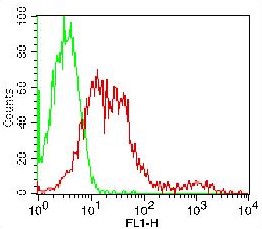Human MAG / GMA / Siglec-4 Recombinant Protein (His Tag)(Discontinued)
Shipping Info:
For estimated delivery dates, please contact us at [email protected]
| Amount : | 100 µg |
| Purification : | > 95 % as determined by SDS-PAGE |
| Content : | Formulation Lyophilized from sterile PBS, pH 7.4 Normally 5 % - 8 % trehalose, mannitol and 0.01% Tween80 are added as protectants before lyophilization. |
| Storage condition : | Store it under sterile conditions at -20°C to -80°C. It is recommended that the protein be aliquoted for optimal storage. Avoid repeated freeze-thaw cycles. |
| AA sequence : | Met1-Pro516 |
| Alternative Name : | GMA Protein, S-MAG Protein, SIGLEC-4A Protein, SIGLEC4A Protein, |
Source : HEK293 Cells
The myelin-associated glycoprotein (MAG) contains five immunoglobulin-like domains and belongs to the sialic-acid-binding subgroup of the Ig superfamily. MAG is a transmembrane glycoprotein of 1kDa localized in myelin sheaths of periaxonal Schwann cell and oligodendroglial membranes where it functions in glia-axon interactions. It appears to function both as a receptor for an axonal signal that promotes the differentiation, maintenance and survival of oligodendrocytes and as a ligand for an axonal receptor that is needed for the maintence of myelinated axons. MAG contains a carbohydrate epitope shared with other glycoconjugates that is a target antigen in autoimmune peripheral neuropathy associated with IgM gammopathy and has been implicated in a dying back oligodendrogliopathy in multiple sclerosis. MAG is considered as a transmembrane protein of both CNS and PNS myelin and it strongly inhibits neurite outgrowth in both developing cerebellar and adult dosal root ganglion neurons. In contrast, MAG promotes neurite outgrowth from newborn DRG neurons. Thus, MAG may be responsible for the lack of CNS nerve regeneration and may influce both temporally and spatially regeneration in the PNS.
The myelin-associated glycoprotein (MAG) contains five immunoglobulin-like domains and belongs to the sialic-acid-binding subgroup of the Ig superfamily. MAG is a transmembrane glycoprotein of 1kDa localized in myelin sheaths of periaxonal Schwann cell and oligodendroglial membranes where it functions in glia-axon interactions. It appears to function both as a receptor for an axonal signal that promotes the differentiation, maintenance and survival of oligodendrocytes and as a ligand for an axonal receptor that is needed for the maintence of myelinated axons. MAG contains a carbohydrate epitope shared with other glycoconjugates that is a target antigen in autoimmune peripheral neuropathy associated with IgM gammopathy and has been implicated in a dying back oligodendrogliopathy in multiple sclerosis. MAG is considered as a transmembrane protein of both CNS and PNS myelin and it strongly inhibits neurite outgrowth in both developing cerebellar and adult dosal root ganglion neurons. In contrast, MAG promotes neurite outgrowth from newborn DRG neurons. Thus, MAG may be responsible for the lack of CNS nerve regeneration and may influce both temporally and spatially regeneration in the PNS.
1. Measured by its ability to bind mouse RTN4R-Fc2h in functional Elisa. 2. Measured by its ability to bind human RTN4R-Fch in functional Elisa.
Endotoxin :< 1.0 EU per µg of the protein as determined by the LAL method.
Other pack size also available.
For Research Use Only. Not for use in diagnostic/therapeutics procedures.
|
There are currently no product reviews
|






















.png)








